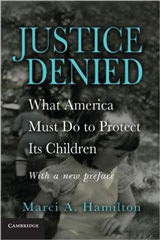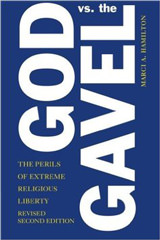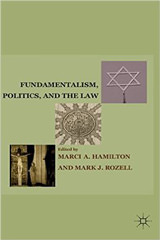This is the first part in a three-part series on the 2016 election. The series will cover education, reproductive rights, and LGBTQ rights.
President-elect Donald Trump has selected Betsy DeVos to be his Secretary of Education. Few outside the conservative religious movement can fully apprehend what this means. It may well mean the end of the Department of Education itself, although it is more likely that it makes the Department the driving force to dismantle public schools to the benefit of religious schools.
Some have said that the Trump presidency will be post-ideological, but he has made appointments and made promises that indicate his intention to cement the ideology of the conservative religious coalition.
The Construction of a Doctrine at the United States Supreme Court to Deconstruct American Education
Since 1962 when the Supreme Court in Engel v. Vitale held that public schools may not sponsor school prayer, social conservatives have been critical of the public school system. That opposition has taken several paths including an increase in homeschooling and attacks on public schools. The agenda has been to divert tax dollars away from the public school system to school vouchers, or as they became known, “school choice.” School choice, though, was only desirable where it encompassed private religious schools as well as charter and other private schools.
In order to steer public tax dollars away from the public schools to religious schools, a series of constitutional barriers needed to be surmounted. The following is a short history of the Supreme Court cases that form the basis for the path that Betsy DeVos has advocated.
The right of religious communities and believers to avoid compulsory school laws. The Amish challenged Wisconsin’s compulsory school law in Wisconsin v. Yoder, arguing that their children should not have to complete the full number of years of schooling required of all other students. Instead, their way of life required that children leave high school to be trained in an agrarian culture. The Supreme Court, in a decision written by conservative Chief Justice Warren E. Burger held that the Amish are an otherwise law-abiding community who had the right to remove their children from the full educational time span. Justice William O. Douglas dissented in part because the decision was based solely on the views of the parents. Rather, children are “persons” under the Constitution and, therefore, the Court should have left open the possibility that a high-school-aged child would choose to be educated despite her parents’ religious beliefs.
The right of proselytizing student organizations to receive school funding on a theory that they are equal to all other student organizations. An evangelical student organization at the University of Virginia argued that it had the right to receive funding as a student group, alongside every other student group, even if its primary activity was proselytizing. The argument in opposition was that the Establishment Clause barred the government from funding religious speech and mission directly. In a 5-4 decision, in Rosenberger v. Rector and Visitors of the University of Virginia, the Supreme Court held that if Virginia was providing dollars to other student groups, it could not deny funding to a group whose primary activity was religious. This case was a dramatic turning point in church-state doctrine as it followed the reasoning that religious organizations have a right to be treated “equally” in the educational process by the government, and exclusion from a funding program was unconstitutional.
A school district may provide vouchers to students to attend charter, private, and other public schools. The Supreme Court was asked to consider whether the Cleveland City School District could distribute vouchers to parents of students to attend private religious schools, charter schools, and suburban public schools. The vouchers were $2,250 and were limited to those students with demonstrated financial need. The vast majority of the funds, 96 percent, flowed to private religious schools. The system was attacked as a violation of the separation of church and state in Zelman v. Simmons-Harris, in which the Supreme Court held in a 5-4 decision that the system was constitutional because it provided “true choice” to parents. Because the parents made the choice between schools, the government could not be deemed to be directly funding religious schools.
A religious school can discriminate at will against a teacher on any ground if the teacher is deemed a “minister” though not a member of the clergy. It has long been accepted in constitutional law that religious organizations have the right to choose their clergy according to their own lights. For example, the Catholic Church can exclude women from the priesthood and the Southern Baptist Convention can exclude LGBTQ and women from being pastors. This left open two questions. First, could religious organizations engage in discrimination against clergy that is not religiously motivated. For example, could a Catholic church engage in race discrimination against a priest even though there is no belief that race is a factor in choosing clergy? Second, does the right to discriminate extend beyond ordained clergy. In Hosanna-Tabor Evangelical Church and School v. EEOC the Supreme Court answered both questions in the affirmative, holding that a religious school was immune from the discrimination lawsuit brought by a teacher under the Americans with Disabilities Act, and that even though she was not ordained clergy, her duties were sufficiently religious to make her a “minister” permitting the church to discriminate at all.
The Educational Agenda of the Conservative Religious Coalition
The educational agenda of the conservative religious coalition is two-fold: autonomy from the compulsory education and anti-discrimination laws and financial support from the government. The laws they seek to avoid include curriculum and testing requirements, anti-discrimination laws protecting sexual orientation, and mandated sex education, not to mention the provision of birth control to students. To state it from the other side: they seek the right to be able to craft the curriculum to their religious lights, including insertion of creationism in the science curriculum; to discriminate against teachers and students who are LGBTQ; and to avoid fact-based sex education. Many also seek to instill beliefs asserting the inferiority of women to men.
Home schoolers have argued that they should not have to abide by the curriculum requirements of the state, and even that the state’s attempts at enforcement of such standards themselves violate their rights.
With Hosanna-Tabor, their agenda extended well beyond curriculum and the avoidance of gay rights to being able to require all teachers to reflect their religious beliefs. Since the decision, Catholic dioceses have fired teachers for being pregnant and unmarried and for being gay and married, among other reasons, arguing that parochial school teachers are “ministers” and, therefore, the teachers do not get the benefit of the anti-discrimination laws.
In addition to seeking to construct an autonomous universe within their schools, they have argued that public funds should be capable of being diverted from public schools to private religious schools. This project began with the Supreme Court’s first Establishment Clause case, Everson v. Board of Education, in which the Court held that New Jersey could expand busing of students to school from public schools to include all schools, even when over 90 percent of the schools receiving the benefit were religious. Busing was just the beginning; following Everson religious schools successfully lobbied to obtain various items from textbooks to computers. The next logical step in their reasoning is tuition.
So far, this account has described what appears to be private religious schools on a parallel track with the public schools, but that is just a stop on the way to the ultimate goal. This is where Betsy DeVos’s vision comes in.
The Coup de Grace: Appointment of Betsy DeVos as Education Secretary
Betsy DeVos is a very wealthy and religious woman who has dedicated numerous years of her life in Michigan to remake the public school system by inserting more charter and for-profit schools, alongside religious private schools. According to many, her track record in Michigan has not been stellar. She has been accused of creating a “deeply dysfunctional educational landscape” while being “willfully impervious to the relevant data.” From a child-centered perspective, this denotes failure and that she operates more as an ideologue than someone motivated by the welfare of children. The following is a recent description of the current Detroit educational scene:
In Detroit, parents of school-age children have plenty of choices, thanks to the nation’s largest urban network of charter schools.
What remains in short supply is quality.
In Brightmoor, the only high school left is Detroit Community Schools, a charter boasting more than a decade of abysmal test scores and, until recently, a superintendent who earned $130,000 a year despite a dearth of educational experience or credentials.
On the west side, another charter school, Hope Academy, has been serving the community around Grand River and Livernois for 20 years. Its test scores have been among the lowest in the state throughout those two decades; in 2013 the school ranked in the first percentile, the absolute bottom for academic performance. Two years later, its charter was renewed.
Some I am sure will say that Detroit is not her fault for some reason, but then it is important to consult the ideology that is informing her drive to reform American education. This is where we get back to the conservative religious agenda. While she claims not to be motivated to destroy the public schools, Detroit notwithstanding, she is motivated by a desire to “advance God’s Kingdom.” But even more important to understanding her mission is that she believes that the challenge to public schools is needed because they have displaced the church, which should be instead the locus of the local community. She seeks much more “local” control of schools.
When one pairs the desire for local control with the Devos’s history of supporting conservative, anti-LGBTQ organizations like Focus on the Family, it suggests what “local” may actually mean. It sounds like code for avoiding the societal forces that have transformed the LGBTQ from hated minority to “persons” for constitutional purposes.
Let’s play out this concept of local, church-centered education. In fact, one need not construct a hypothetical. There are already many religious communities that reveal what happens when one religious organization controls the educational system, without public accountability. The ultra-Orthodox Jewish community has failed to educate its boys and has taken over local school boards, as I discuss here. Some of the men who grew up in the community and weren’t even taught English, let alone math and science, in these religiously insular communities controlled by clergy, have filed a lawsuit against the New York State Department of Education. The federal government also seized documents to investigate funding of the yeshiva’s. But ultra-Orthodox Jews are just one isolated religious community that has failed to adequately educate their young while pursuing a robust locally-controlled religious community.
Thus, it is incumbent on DeVos to explain her ultimate goal of local control in a church-centered community. The Supreme Court has opened the pathway to achieve much of what she appears to envision, though not all. Her ideology, however, raises serious questions about whether her appointment is consistent with the best interests of our nation’s children.
Just as importantly, the American public needs to understand that Trump is committed to furthering the conservative religious agenda that has been building for decades. This will indeed by an ideologically-driven presidency.










I am sometimes troubled by the lines drawn here but do not take the somewhat atypical strong stance from a fairly conservative sort here. For instance, Hosanna-Tabor Evangelical Church and School v. EEOC involves someone deemed a “minister” and it is appropriate there to give (based on freedom of association alone) the organization a right to choose the rules for teachers of the faith (at least up to a point — e.g., notification of child abuse).
Likewise, generally, free exercise sometimes should involve special discretion involving acts. So, I think Yoder was rightly decided, especially given it involved a mixture of claims, including the right to educate a child as one deems fit (again up to a point — eight years of education plus de facto technical school — farming — was an acceptable line especially if the parents are required to provide some additional religious based education).
RFRA has been taken too far, especially when third parties are involved (employees, the public/students especially regarding vaccines etc.), and I appreciate Prof. Hamilton’s pushback there. Even if I think she goes too far at some point, it provides a helpful balance.